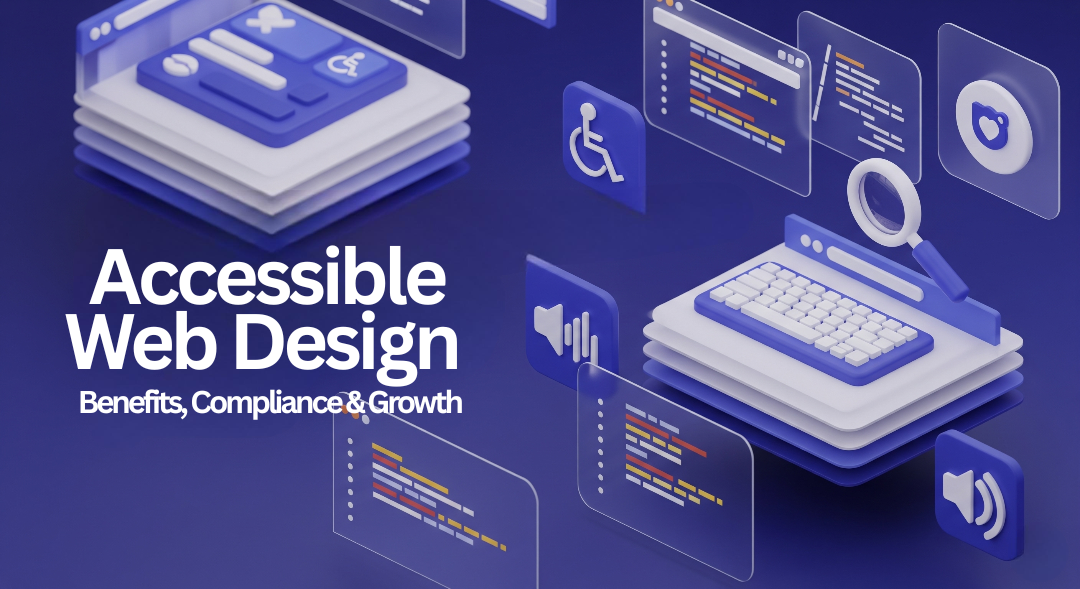Today, it’s almost impossible not to use the internet. It provides billions of people across the globe access to opportunities and services as well as information. This vast digital space should be available and accessible to all, regardless of abilities. The web development tools play an essential role in increasing diversity. In 2025, the accessibility of websites is more than an ethical concern. It will become a central corporate strategy. A changing law and the growing popularity of the internet make it an essential part of having a strong online presence. Companies need to make their websites accessible to all.
2025 is an important moment in the realm of accessibility to digital media. This blog post will take a look at the various benefits of focusing on accessibility in web design by 2025, from a simple compliance point to a strategic benefit for any web presence.
Table of Contents
1. The Evolving Legal and Regulatory Landscape
The digital age is becoming more controlled, so 2025 is a crucial year for accessibility compliance.
European Accessibility Act (EAA) The EAA is a landmark law that goes into effect on June 28th, 2025. It requires that a broad selection of digital goods and services, including mobile apps, websites, E-commerce platforms, travel, and banking information, be made available.
- Mandatory Nature Mandatory Nature EAA provides accessibility as an obligation under the law for certain sectors that are part of the EU.
- Inability to meet these standards is subject to severe penalties, including fines, legal action, and significant damage to their reputation.
Wcag 2.1/2.2 and the transition to Wcag 3.0 It The Web Content Accessibility Guidelines (WCAG) remain the standard worldwide for accessibility.
- WCAG 2.2 extends earlier versions that have tighter standards, with a focus on the navigation of keyboards, consistency in navigation patterns, and increasing usability for people who have cognitive impairments.
- The WCAG 3.0 Horizon. This next generation will focus on the user’s experience and takes an integrated, customized accessibility approach that can move away from an approach based on checklists.
Global Push and Increased Enforcement: We are seeing an increase in accessibility-related cases worldwide, particularly under the Americans with Disabilities Act (ADA) in the United States.
- Rising litigation: The pattern indicates that the legal issues of websites that aren’t accessible are more pressing than ever before.
- Legal Importance Accessibility is not just an ethical choice but an obligation of law to prevent costly lawsuits and ensure the accessibility of markets to all.
2. Grow Your Market Reach and Audience
Accessible design is an essential instrument to help businesses succeed by providing access to digital technology to a huge, and often underserved, segment of the population.
The Untapped Disability Market:
- More than 15% of the people around the globe suffer from one form or another of handicap. The number is higher than a billion.
- The population is extremely potential for income, influence, and disposable income. In the event of a website not being accessible, it obstructs an enormous and important client base. However, a receptive site welcomes customers with a warm welcome.
Inclusion Of Older Adults:
- The population of the world is growing quickly. Senior citizens are often affected by deficiencies due to age, such as a decline in motor or vision.
- Accessible design principles like large fonts, sufficient contrast of colors, easy navigation, and simple layouts significantly help this growing market.
- The design choices help users to communicate with your services and information.
Improved User Experience For All:
- All visitors, even those with disabilities that are permanent, can benefit from the improved overall user experience that is provided by accessibility features.
- Take into consideration someone who has an injured arm, who can use an alternative mouse or an eye problem that requires high contrast.
- Limitations of the Situation: Users who live in high-intensity environments, in noisy areas, or with weak internet connections can benefit from simple, user-friendly interfaces.
- Benefits: This means lower bounce rates, greater user engagement, and better perception of your website in general.
3. Improve Your Brand’s Reputation and Loyalty
In 2025, the values of brands and social responsibility will become major factors in influencing consumer choices. A web-friendly design that is accessible supports this.
Ethics And Social Responsibility:
- The importance of accessibility is to position your business as one that is committed to the diversity of its employees and their equality.
- The public is increasingly aware of the values upheld by the businesses they trust. Socially responsible companies are often rewarded with more trust and loyalty.
Enhanced Brand Image and Trust:
- An emphasis on open design can enhance your brand’s image, portraying your company as innovative and thoughtful.
- It helps build confidence with your customers, which results in stronger relationships with them.
- This positive impression can make you stand out from the competition.
Competitive Advantage:
- In a highly competitive digital market, having a website that is easily accessible is a key point of differentiation. It attracts customers who value diversity and appreciate it.
- The positive word-of-mouth of happy customers, particularly those who have impairments, could be very effective in bringing awareness and boosting your image naturally.
4. Tangible Business Benefits and ROI
Beyond the ethical considerations, investing in readily available web development services can bring tangible operational and financial benefits.
Improved Seo Performance:
- A lot of accessibility best practices are directly linked to enhancing the effectiveness of Search Engine Optimization (SEO).
- Examples include semantic HTML, which provides descriptions of alt text for images, incorporates video transcripts, and ensures clear heading structures that aid search engines in scanning and indexing your website.
- Results: These strategies aid in improving the search engine rankings and increasing organic traffic.
Increased Conversions And Sales:
- A site that is easily accessible is, by definition, more user-friendly.
- Conversion rates naturally rise as visitors can swiftly browse your website and perform the actions they want to do (for instance, making a purchase or joining an account, or filling out the form).
- It has an immediate impacton the bottom line as well as an increase in income.
Lower Legal Risks and Costs:
- An investment in accessibility that is proactive will protect against expensive legal disputes.
- Making accessibility a priority at the beginning is much cheaper than battling lawsuits, massive fines, or expensive, lengthy retrofits later on.
- Eliminating these risks will save your finances and the image of your brand.
Futureproofing Your Digital Presence:
- Making sure that accessibility is considered right from the beginning is essential to create an adaptable and flexible website.
- This method will eliminate the need for expensive overhauls in the future, if standards evolve or new technologies are introduced.
- It makes sure the digital asset you have is secure and reliable in the long run.
5. Key Accessibility Trends and Best Practices for 2025
The accessibility landscape is constantly evolving, with new technology and new methods emerging.
AI’s Role In Accessibility:
- Artificial intelligence is progressively increasing accessibility.
- Applications: AI-powered solutions offer live captioning that is real-time as well as more precise alternative descriptions of text for photos, and improve the web-based navigation capabilities of voice assistants. capabilities.
Designing For Inclusivity From The Start:
- There is a significant shift away from “fixing later” to incorporating accessibility throughout the process of design, development and maintenance.
- Benefits: Making accessibility available during the planning phase is more efficient, economical and produces the highest quality finished product.
User-centric Testing:
- Participating actual disabled users in the process of testing is becoming increasingly recognized as vital.
- The reason: This helps ensure the real-world experience and helps identify any obstacles that automated tools could miss.
Continuous Monitoring:
- Web accessibility demands ongoing commitment, not a one-time commitment.
- Ensuring compliance and giving everyone the best user experience requires regular reviews, updates, and monitoring.
- If you’re looking to employ a designer for ui/ux who has experience in accessibility, make sure they’re up-to-date with the latest developments in accessibility. When hiring web developers, be sure that they know accessibility-friendly coding methods as well as are dedicated to ongoing advancement.
Adopting accessible web design by 2025 goes beyond reaching legal standards. It shows a strong dedication to inclusion as well as a strategic vision. It extends your reach on the internet to a greater number of people. It significantly improves your brand’s image. In the end, it can lead to great business results. It is recommended to work with experienced professionals to ensure your website meets the highest accessibility standards.
Mind labs Systems Pvt Ltd provides complete web development services as well as experts to help you build an accessibility-friendly digital experience. By investing in accessibility, you are creating an inclusive, lasting, and successful digital future that is accessible to everyone.

